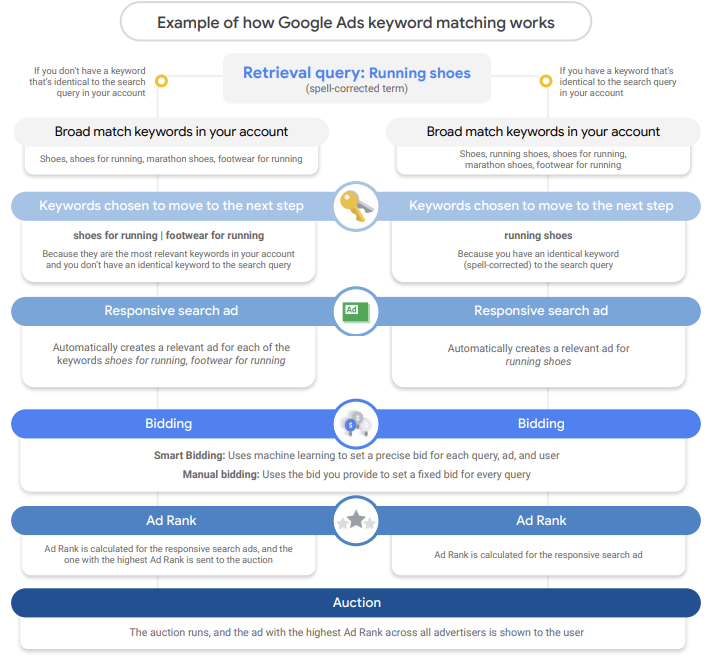During Google’s Search Ads Week, the company offers an inside look at how its keyword-matching system operates.
Google has released a comprehensive 28-page guide detailing how the system selects the best ad to display for a search query.
The guide will help you better understand the Google Ads process and is a valuable resource for optimizing your campaigns.
You can find the chapter of the guide that focuses on keyword matching on page seven.
Here’s a visual representation of the process, followed by a written summary.
 Screenshot from: Google Ads Unlock The Power Of Search, February 2023.
Screenshot from: Google Ads Unlock The Power Of Search, February 2023.Understanding Google Ads’ Keyword Matching Process
The keyword-matching process starts with a user entering a search query.
Google’s system then uses information such as spelling corrections, synonyms, and related concepts to create a retrieval query. This query retrieves all relevant keywords that are enabled to serve.
Google uses machine learning and natural language understanding technologies to determine keyword eligibility based on keyword match type, campaign, and ad group criteria.
The system requires a strict match for exact keywords, while phrase and broad match keywords allow for more general matching.
The system checks for the campaign and ad group eligibility based on budget, geotargeting, audience targeting, negative keywords, and time of day restrictions.
If a campaign uses broad match, the system considers the user’s location, recent searches, and landing page, among other signals.
Responsive Search Ads
Once Google’s system determines keyword and campaign/ad group eligibility, it selects the best-performing creative for the user.
This is done through the responsive search ads creative system, which automatically assembles the best-performing creative from available headlines and descriptions.
The candidate ads are evaluated for relevance to the user’s query, and the creative expected to perform best is selected.
Bids & Ad Rank
Google’s keyword-matching system then calculates bids for use with Ad Rank.
Ad Rank is a value that determines where ads are shown on a page relative to other ads and whether your ad will show at all.
With Smart Bidding, a unique, optimal bid is set for each ad impression combination based on the likelihood that the ad, with the specific landing page, for the particular user search query and intent, will lead to a conversion.
If a campaign uses manual bidding, the system will only use the static bid provided and any relevant bid modifiers.
The system selects the best combination of relevance and Ad Rank among the ad candidates. These candidates include a matched keyword or landing page, a creative, and a bid.
Final Auction
Finally, relevance is determined by looking at the meaning of the search term, the meaning of all the keywords in the ad group, and the landing page within the ad group.
If broad-match keywords are eligible to match, only relevant broad-match keywords from the most relevant ad groups will be selected.
The ad with the highest Ad Rank from each advertiser enters the auction, and the ads with the highest Ad Rank across all advertisers show.
Importance Of Grouping Keywords
It’s important to note Google’s system eliminates the need to add the same keyword in multiple match types to funnel traffic to certain areas of your account.
When you duplicate keywords in separate ad groups or campaigns, it can segment and reduce the available data that Smart Bidding can use for optimization, which may result in fewer conversions and higher costs.
It can also increase the margin for error and make it harder to have consistent ads, budgets, targets, etc., across many campaigns and keywords.
In Summary
Advertisers can optimize their campaigns for better results by understanding the Google Ads keyword-matching process.
Google’s guide offers a comprehensive system breakdown, including how Google uses machine learning and natural language understanding technologies to determine keyword eligibility and how the responsive search ads creative system selects the best-performing creative for the user.
It’s important to note that grouping keywords is crucial to optimizing campaigns. By eliminating the need to add the same keyword in multiple match types, advertisers can avoid segmenting and reducing the available data that Smart Bidding can use for optimization, resulting in fewer conversions and higher costs.
Overall, the guide is a valuable resource for digital marketers looking to improve their Google Ads campaigns. Utilizing the insights and best practices provided in the guide can increase your chances of success and drive more conversions.
Featured Image: RoseRodionova/Shutterstock
